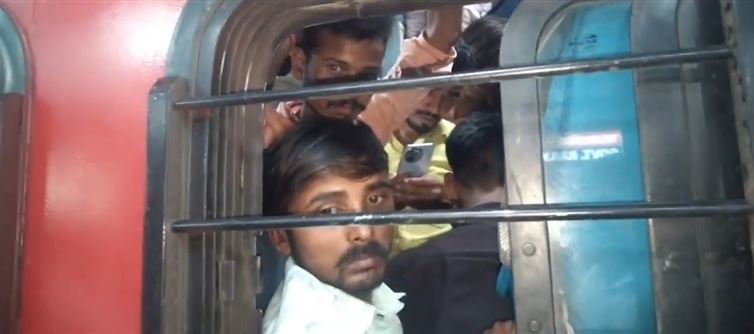
A NATION IN MOTION — WITHOUT DIGNITY
Aboard the Awadh assam Express, a man sits motionless in a suffocating coach. Twenty-four hours without standing. Twenty-four hours without water. Twenty-four hours without dignity.
He hasn’t gone to the washroom — not because he doesn’t need to, but because there’s no space to move. He says softly, “I fear drinking water.”
This is not a rare story. It’s the lived reality of thousands who board trains hoping to reach work, families, or a better tomorrow — but end up trapped in a nightmare on wheels.
They call it Amrit Kaal — an age of glory. But for India’s railway passengers, it’s starting to feel more like Agni Pariksha Kaal — an age of endurance.
THE GREAT indian train ILLUSION
Every Independence Day, every speech, every slogan is peppered with numbers: “12,000 special trains.” “Record passenger movement.” “Viksit Bharat on track.”
But where are these “special trains” when millions are crammed into rusting coaches, sitting shoulder to shoulder, gasping for air, and dehydrating out of fear?
The gap between what’s said and what’s seen has never been wider. The indian Railways, once hailed as the pride of the nation, now stands as a mirror — reflecting how hollow our development rhetoric has become.
In the name of modernisation, passengers are promised bullet trains. But what they get instead are “bullet wounds” to their dignity.
THE COACH OF DESPAIR
Walk into any general compartment of a long-distance train — say, the Awadh assam Express, Purvottar Sampark Kranti, or Poorva Express — and you’ll see humanity at its breaking point.
Men standing for hours because there’s no room to sit.
Women clutching their children tightly, afraid someone might crush them in the crowd.
People are avoiding water because it might force them to face the unspeakable horror of the washroom.
Cockroaches crawl freely across the floors. The stench of sweat, rot, and metal fills the air. Yet, everyone sits silently. Because they must. Because for many of them, there’s no other way home.
As one passenger said, “Even cockroaches live better than this. At least they can move.”
DEHYDRATION AS A SURVIVAL STRATEGY
Imagine fearing water. Imagine sitting 24 hours still, holding your bladder, fighting thirst, and praying you don’t faint.
That’s the survival strategy for thousands of migrants and daily wage workers who depend on these trains. For them, dehydration isn’t a mistake — it’s self-preservation.
They can’t afford to drink.
They can’t afford to move.
They can’t afford to complain.
Their only goal: survive the journey.
This isn’t just discomfort — it’s a slow, silent humiliation of human endurance, unfolding every day across the nation’s railway network.
THE LUXURY OF APATHY
In air-conditioned compartments, influencers post videos of scenic train routes. Politicians wave from gleaming Vande Bharat Expresses. Bureaucrats hold press conferences about “revamping indian Railways.”
Meanwhile, in the next coach — just a few feet away — human beings are being packed like cattle.
This contrast is not just cruel — it’s symbolic. It shows who India’s progress is designed for, and who’s left gasping on the floor.
The divide between “Digital India” and “Desperate India” runs right through the middle of a train coach.
THE INVISIBLE WORKFORCE ON WHEELS
Every face in that crowded compartment has a story — of leaving home because there are no jobs in Bihar, assam, Jharkhand, or Uttar Pradesh.
They build India’s cities, clean its streets, carry its bricks, drive its cabs, serve its tea. And then, they go back — like this. Squeezed between strangers, dehydrated, invisible.
These are not passengers. These are the lifelines of the nation forced to travel without life.
When we talk about unemployment or migration, this is what it looks like — not in policy reports, but in the eyes of men too scared to drink water.
“AMRIT KAAL” OR “AUSTERITY KAAL”?
The government calls this the era of Amrit Kaal — the age of nectar. But what nectar do the poor taste, when all they get is neglect?
The trains that should represent India’s progress have become its most haunting metaphor — fast on promises, derailed on reality.
In this so-called golden era, even dignity has a class compartment.
WHERE IS THE OUTRAGE?
Where are the headlines? The hashtags? The viral outrage that usually follows celebrity scandals or political theatrics?
Why is it that the suffering of millions traveling home every day — dehydrated, suffocating, forgotten — doesn’t make the news cycle?
Because they are too ordinary. Too poor. Too voiceless to trend.
And that’s the tragedy: their invisibility is what keeps the system comfortable.
EPILOGUE: THE train TO NOWHERE
As the Awadh assam Express rolls on, so does india — loud speeches, bright slogans, and all.
But somewhere in Coach S5, a man sits silently, afraid to drink, afraid to move. The wheels keep turning, but progress stands still.
He doesn’t need a “special train.”
He needs basic humanity.
Until that arrives, every train in this so-called Amrit Kaal is just another Express to Indignity.




 click and follow Indiaherald WhatsApp channel
click and follow Indiaherald WhatsApp channel